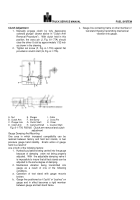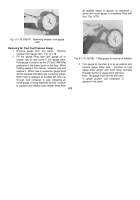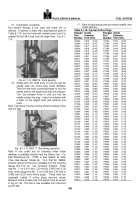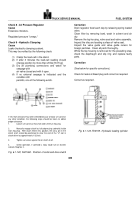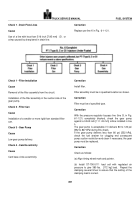TM-5-3805-254-14-P-2 - Page 487 of 894
TRUCK SERVICE MANUAL
FUEL SYSTEM
ST-790 Trouble Shooting
ST790 Trouble Shooting/Maintenance
This section of the manual should be fully understood by
the Injector Test Stand operator, and through this
knowledge he should be able to correct the test stand
problems
and
subsequently
produce
a
properly
calibrated injector.
The ST790 Injector Test Stand is the recommended
calibration equipment for Cummins injectors and was
developed to provide accurate balancing and testing of
Cummins injectors in order to produce the desired
engine performance.
Injector calibration on the ST790 Injector Test Stand
combined with fuel pump calibration on
Cummins Fuel Pump Test Stands with flow
meters has produced widespread acceptance of
fuel system accuracy.
There have been reports
of erratic results, but investigations have
revealed that the cause for such
problems fall into three basic categories.
1. Mechanic and/or Tester Error:
(Not confined to
injector calibration alone.
Includes pump
calibration, engine and chassis dynamometer
checks, etc.)
2. Instrumentation Errors:
(Range
all
way
from
gauge used on cuptoplunger seat check to load
indicator on chassis dynamometer.
3. ST790 Maintenance Status These three problem
areas are itemized as follows:
a. Mechanic and/or Tester Error
1. Calibrating a specific injector model to the wrong
flow value.
2. Calibrating a specific fuel pump model to the
wrong value.
3. Lack of familiarity with this bulletin and/or Bulletin
No. 3379068, 983505, 3379084 and No.
983533.
4. Use of wrong injector assembly in a specific
engine model.
5. Use of camshaft and pistons other than those
shown in CPL.
6. Restricted intake air to engine.
7. Excessive exhaust back pressure.
8. Restricted fuel supply to engine.
9. Aerated fuel supply to engine.
10. Excessively high oil level in engine crankcase.
b. Instrumentation Errors (Other than ST790) 1.
Erroneous fuel manifold pressure gauges on
engine and/or chassis dynamometer.
2. Erroneous flowmeters.
3. Erroneous dynamometer load indicators.
c. Neglect of ST790 Maintenance.
1. Use of hose lengths, diameters, and resiliencies
other than those which are specified.
Caution:
Do not replace any hoses or lines on the
ST790 Test Stand with other than the correct ST hose as
specified in the tool catalog.
Hoses on ST790 should be
replaced periodically since rubber in the hose hardens
with age causing resonance variables.
2. Fuel routing which is not to specifications.
3. Filter assemblies which have a different
dampening effect on the system.
4. Critical components of the test stand such as
check valve, gauge and hydraulic injector
clamping poorly maintained.
Trouble Shooting The ST790
Injector
calibration
problems
are
discovered
by
inconsistent results in service injectors or inability to flow
injectors which have been calibrated at the factory or at
other locations to the proper specifications.
When an
injector calibration
problem
is
indicated,
the
following
troubleshooting guide is to be used in the diagnosis and
correction of the problem.
All injector calibration
complaints have been found to fall into the six basic
categories as follows.
1. Stand repeatability.
Stand will not repeat
consistently on any given injector.
2. Poor results on all injector models.
Injectors do
not perform well in engine and do not correlate
with injectors calibrated on other stands.
3. NHRS, NRT injectors heavily overfueled.
PT
(type B) and PT (type D) injectors slightly
underfueled.
Reasonable results on all other
injectors.
4. All PT (type B) (type C) and PT (type D) injectors
overfueled.
Reasonable results on all other
injectors.
5. NHRS, NRT and all PT (type B) (type C) and PT
(type D) injectors overfueled.
Results are
reasonable with all other injectors.
6. All PT (type B) (type C) and PT (type D) injectors
underfueled.
482
Back to Top

